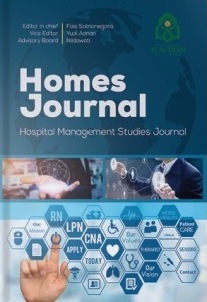HOSPITAL FOOD SERVICE ASSESSMENT IMPROVING NUTRITIONAL INTAKE INPATIENTS: A LITERATURE REVIEW
Abstract
Background: Malnutrition in hospitals is a commonly occurring and often overlooked issue that impacts not only the clinical outcomes of patients, such as their length of stay, morbidity, mortality, and quality of life, but also the overall sustainability of the healthcare system. column format. Aims: The purpose of writing this systematic literature review is to collect scientific evidence regarding food service satisfaction assessment techniques for inpatients in hospitals. Method: This research conducting a literature review using PRISMA guidelines, using data based on Google Scholar and Scopus which examined the level of patient satisfaction with food services in hospitals.
Result: From the six papers that we analyzed, we obtained an assessment process for the level of patient satisfaction using caloric intake calculations, and some used validated questionnaires, and obtained several appropriate strategies to increase the nutritional intake of inpatients. Conclusions: Assessing the patient's nutritional and nutritional intake is very important in determining the patient's health and recovery.
References
Alqurashi, N. A., Priyadarshini, A., & Jaiswal, A. K. (2019). Evaluating Food Safety Knowledge and Practices among Foodservice Staff in Al Madinah Hospitals, Saudi Arabia. Safety, 5(1), Article 1. https://doi.org/10.3390/safety5010009
Barker, L., Gout, B. S., & Crowe, T. (2011). Hospital Malnutrition: Prevalence, Identification and Impact on Patients and the Healthcare System. International Journal of Environmental Research and Public Health, 8, 514–527. https://doi.org/10.3390/ijerph8020514
Beavan, S., Baker, R., Sadler, H., & Collinson, A. (2019). Improving the nutritional intake of hospital patients: How far have we come? A re-audit. Journal of Human Nutrition and Dietetics, 32(3), 372–384. https://doi.org/10.1111/jhn.12607
Beelen, J., Vasse, E., Janssen, N., Janse, A., de Roos, N. M., & de Groot, L. C. P. G. M. (2018). Protein-enriched familiar foods and drinks improve protein intake of hospitalized older patients: A randomized controlled trial. Clinical Nutrition, 37(4), 1186–1192. https://doi.org/10.1016/j.clnu.2017.05.010
Blondal, B. S., Geirsdottir, O. G., Halldorsson, T. I., Beck, A. M., Jonsson, P. V., & Ramel, A. (2022). HOMEFOOD randomised trial – Six-month nutrition therapy improves quality of life, self-rated health, cognitive function, and depression in older adults after hospital discharge. Clinical Nutrition ESPEN, 48, 74–81. https://doi.org/10.1016/j.clnesp.2022.01.010
Chin, E. L., Simmons, G., Bouzid, Y. Y., Kan, A., Burnett, D. J., Tagkopoulos, I., & Lemay, D. G. (2019). Nutrient Estimation from 24-Hour Food Recalls Using Machine Learning and Database Mapping: A Case Study with Lactose. Nutrients, 11(12), Article 12. https://doi.org/10.3390/nu11123045
Dahka, S. M., Gholamalizadeh, M., Shadnoush, M., Roomi, N., Shafahi, H., Doaei, S., & Ajami, M. (2022). The status of clinical nutrition in hospitals of Guilan province, Iran—A mixed-method study. Nutricion Hospitalaria, null, null. https://doi.org/10.20960/nh.04239
Ferreira, D. C., Marques, R. C., Nunes, A. M., & Figueira, J. R. (2021). Customers satisfaction in pediatric inpatient services: A multiple criteria satisfaction analysis. Socio-Economic Planning Sciences, 78, 101036. https://doi.org/10.1016/j.seps.2021.101036
Fink, M., Simons, M., Tomasino, K., Pandit, A., & Taft, T. (2022). When Is Patient Behavior Indicative of Avoidant Restrictive Food Intake Disorder (ARFID) Vs Reasonable Response to Digestive Disease? Clinical Gastroenterology and Hepatology, 20(6), 1241–1250. https://doi.org/10.1016/j.cgh.2021.07.045
Gomes-Neto, A. W., van Vliet, I. M. Y., Osté, M. C. J., de Jong, M. F. C., Bakker, S. J. L., Jager-Wittenaar, H., & Navis, G. J. (2021). Malnutrition Universal Screening Tool and Patient-Generated Subjective Global Assessment Short Form and their predictive validity in hospitalized patients. Clinical Nutrition ESPEN, 45, 252–261. https://doi.org/10.1016/j.clnesp.2021.08.015
Haddaway, N. R., Page, M. J., Pritchard, C. C., & McGuinness, L. A. (2022). PRISMA2020: An R package and Shiny app for producing PRISMA 2020-compliant flow diagrams, with interactivity for optimised digital transparency and Open Synthesis. Campbell Systematic Reviews, 18(2), e1230. https://doi.org/10.1002/cl2.1230
Hajesmaeel-Gohari, S., Khordastan, F., Fatehi, F., Samzadeh, H., & Bahaadinbeigy, K. (2022). The most used questionnaires for evaluating satisfaction, usability, acceptance, and quality outcomes of mobile health. BMC Medical Informatics and Decision Making, 22(1), 22. https://doi.org/10.1186/s12911-022-01764-2
Lau, C., & Gregoire, M. B. (1998). Quality Ratings of a Hospital Foodservice Department by Inpatients and Postdischarge Patients. Journal of the American Dietetic Association, 98(11), 1303–1307. https://doi.org/10.1016/S0002-8223(98)00291-0
Mudge, A., Ross, L., Young, A., Isenring, E., & Banks, M. (2011). Helping understand nutritional gaps in the elderly (HUNGER): A prospective study of patient factors associated with inadequate nutritional intake in older medical inpatients. Clinical Nutrition, 30 3, 320–325. https://doi.org/10.1016/j.clnu.2010.12.007
Navarro, D. A., Shapiro, Y., Birk, R., & Boaz, M. (2019). Orange napkins increase food intake and satisfaction with hospital food service: A randomized intervention. Nutrition, 67–68, 100008. https://doi.org/10.1016/j.nutx.2020.100008
Nuryani, N., Ramadhani, F., & Lestari, A. P. (2020). Kepuasan Pasien Rawat Inap Terhadap Kualitas Pelayanan Makanan Di Instalasi Gizi Rsud Dr. M.M Dunda Limboto. Ghidza: Jurnal Gizi Dan Kesehatan, 4(2), Article 2. https://doi.org/10.22487/ghidza.v4i2.165
Osman, N. S., Nor, N. M., Sharif, M. S. M., Hamid, S., & Rahamat, S. (2021). Hospital Food Service Strategies to Improve Food Intakes among Inpatients: A Systematic Review. Nutrients, 13, null. https://doi.org/10.3390/nu13103649
Sathiaraj, E., Priya, K., Chakraborthy, S., & Rajagopal, R. (2019). Patient-Centered Foodservice Model Improves Body Weight, Nutritional Intake and Patient Satisfaction in Patients Undergoing Cancer Treatment. Nutrition and Cancer, 71(3), 418–423. https://doi.org/10.1080/01635581.2018.1506490
Takagi, K., Buettner, S., & Ijzermans, J. N. M. (2020). Prognostic significance of the controlling nutritional status (CONUT) score in patients with colorectal cancer: A systematic review and meta-analysis. International Journal of Surgery, 78, 91–96. https://doi.org/10.1016/j.ijsu.2020.04.046
Zehra MargotCelik, İ. A., AsliYigit, Fatma EsraGunes. (2019). Evaluation of the Level of Food Consumption and Satisfaction with Hospital Food Services in Elderly Inpatients. Journal, 2(3), 78–85.


